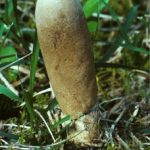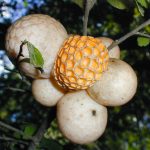Uromyces politus – Tangled Lignum Rust – © M Priest
Some fungi are parasites, both native and introduced. Most are harmless recyclers but some can cause significant damage to plants and other fungi.
In a natural, undisturbed environment, healthy plants are able to repel pathogenic fungi like rusts and smuts.
In monocultures like forestry and agricultural crops, parasitic fungi – rusts, smuts, mildew, mould and others – can spread unchecked and fungicides are widely used for control which also damages beneficial fungi and other soil organisms.

Three species of the Cordyceps genus are known to infect and parasitise the larvae of Oxycanus ssp.– Australian Ghost Moth that feeds on acacia plants.
When the caterpillar burrows into soil to pupate it is invaded, killed by the mycelium and the tissue is absorbed by the fungus leaving only the outermost cuticle of the insect. It lays dormant until weather conditions are favourable for the elongated fruit-body to emerge.
Oddly enough, Cordyceps are claimed by traditional Chinese medicine to have a wide range of health benefits including improving the immune system and respiratory health, preventing certain cancers and slowing down ageing.

Cyttaria Gunnii – Beech Orange is a parasite of Nothofagus cunninghamii – Australian Beech – and forms galls on the branches but does not always kill its the host.



